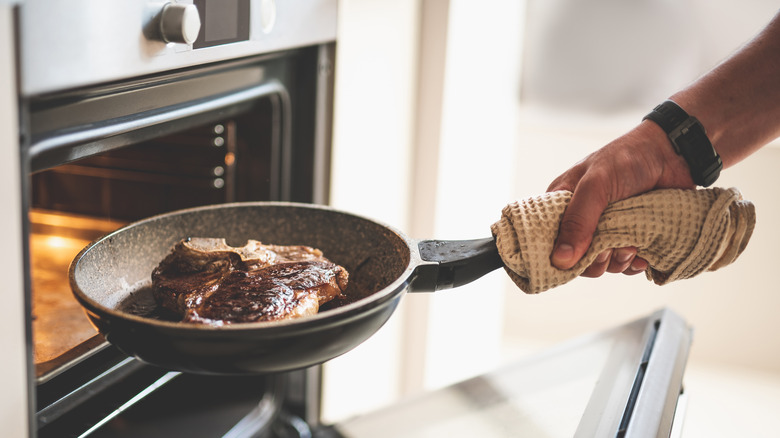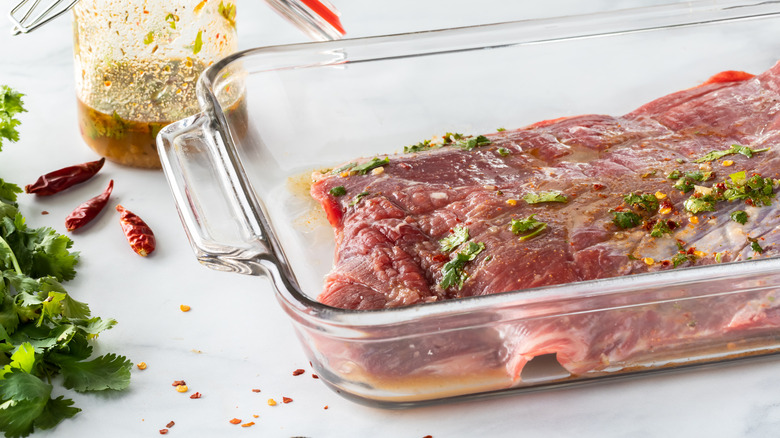Flank steak is a great option for home chefs looking to get a lot of flavor without breaking the bank, but going for the budget option can have some drawbacks. Flank steak is known for being a finicky cut, and if you accidentally keep it on the grill for even a minute too long, you can end up with one that’s dense and chewy rather than tender. Don’t worry, though. If you know what you’re doing, flank steak can be just as delicious as any other, more expensive slab of meat.
The name of the game is high heat and a short cooking time. Flank steak is lean and somewhat fibrous, so the longer you cook it, the tougher it’s going to get. To combat this, we’ll need to make sure our grill is hot enough to get in and out fast. It doesn’t sound so hard, right? And if we marinate the meat beforehand, we’ll give ourselves an even better shot at maximum tenderness.
What is flank steak?

Flank steak is a piece of beef from the flank primal, which sits on the abdomen of the cow. The abdomen gets worked every time the cow moves around, resulting in a characteristically lean piece of meat with little fat content and a decent amount of muscle fiber running through. Flank steak is also a relatively flat cut, which is why it cooks so quickly.
Flank steak is a popular choice for anyone looking for a more affordable cut of beef. It’s not exactly the bottom of the barrel, but it is more affordable compared to more premium cuts. Flank steak is especially popular in fajitas and other recipes that call for sliced steak. It’s known for its strong beefy flavor and is often compared to skirt steak due to its similarly long, flat shape and lean profile. You may be more familiar with it as a bavette, though flank steak is its more common name in the U.S.
Grilled vs. broiled flank steak

Grilled flank steak is the most popular option, but broiling is not uncommon. The standard of high heat and quick cooking time rings true for both, which is why broiling is preferred over roasting. To broil flank steak, you’ll simply set your oven to broil and wait until the oven is ripping hot. You’ll stick the steak in for five minutes, flip it, and cook for another five minutes. That’s it; pull it out and let it sit for another five to ten minutes before cutting into it.
We’re going to get into how to grill a flank steak in a moment, but there isn’t a drastic difference in complexity. With flank steak, because the goal is to cook it quickly before it toughens up, there isn’t a lot of room for extra steps. With both methods, you’re going to get a fairly crisp exterior thanks to the high heat while still leaving the inside nice and tender. If you get the chance, try both and see which you prefer.
Before you grill flank steak

Toasted Pictures/Shutterstock
The most important thing to do before you grill flank steak is to marinate it. Acidic marinades work well for a tougher piece of meat like flank steak, though you’re always free to experiment. There are two main things to remember when marinating your flank steak: the lack of marbling and the high muscle fiber content.
The lack of marbling is what makes flank steak a lean piece of meat. Lack of marbling means lack of fat. You may be thinking that’s a good thing, and maybe it is, but it also makes flank steak tougher to eat and trickier to get right on the grill. By including fat in the form of oil in the marinade, we are giving the meat a better chance of coming out tender. The acid will help soften up all the muscle fibers flank steak is known for. We don’t want to go crazy and make steak caviar or anything, but vinegar or lime juice can help start to break those tougher bits down.
You’ll want to marinate your steak for around four hours. Definitely don’t marinate it for more than 24 hours or the steak can become mushy. Cover the steak in the marinade and stick it in the fridge. Pull the steak out half an hour before you cook it to bring it to room temperature, and pat it dry with a paper towel to ensure a solid sear.
Tenderize it with a meat mallet

Africa Studio/Shutterstock
Flank steak isn’t cut as an evenly shaped block. It’s usually more of a sloping wedge. When you cook it like this, the thinner part will cook faster than the thicker part. It’s not the end of the world, but for a more consistent end result, consider taking a meat tenderizer and giving it a good whack.
This will help with a couple of different problems. First, it will result in a more evenly distributed piece of beef, which means you’ll have more control as you grill it. (No more trying to keep the thickest part closer to the heat.) It will also help tenderize the meat, something flank steak desperately needs. There’s no need to beat it into a pancake; just spend a few minutes getting the steak relatively flat. Remember to use the flat side, not the spiky side, and you’re aiming for a consistent ½ inch thickness.
Heat the grill

Adene Sanchez/Getty Images
You want the grill to be at the right temperature before you put the flank steak on. Never put the meat on before the grill is ready. You shouldn’t be doing this with any steak, but especially not flank steak since your enemy here is time spent on the grill.
If you’re cooking with gas, you’ll want the grill to be at 450 degrees Fahrenheit or, if you don’t have a temperature gauge attached, set it to around medium-high. If you’ve got briquettes, break out the infrared thermometer. We want to blast it to medium-rare and get out before things go sideways. The rule of low and slow does not apply here. Allow the grill to reach the right temperature — about a quarter-hour to ensure the grates are ready to receive your protein.
Place the flank steak on the grill

Quadxeon/Shutterstock
It’s time to start cooking. Hopefully, you’ve seasoned your grill properly so the meat doesn’t stick to the grates. If you’re not sure, apply some oil to them beforehand, so you’re not fighting the meat when you’re trying to flip it.
Once you plop on your steaks, let them sear for 1-3 minutes on each side, depending on thickness and your preferred level of doneness. We should point out, however, that flank steak is best served around medium-rare, meaning you’ll want an internal temperature of 135 degrees Fahrenheit. And it gets there in a flash, so to avoid overcooking, err on the side of less time and toss it back on if it needs it. And don’t forget, even a cut as thin as this will continue to cook outside-to-in as it’s resting, so account for this when pulling them off.
Let the flank steak rest

Olga_Moroz/Shutterstock
Once you’ve removed the flank steak from the grill, allow it to rest for five to ten minutes. Letting steak rest allows the muscle fibers to relax. It also lets the juices, which have retreated to the middle, flow back out to the edges, which gives you a more consistently moist cut.
Letting steak rest is as easy as it sounds. Simply remove it from the grill and place it away from the heat. This can be a plate, a cutting board, or a standing grill. Just remember that juices will flow, so don’t put it anywhere you don’t mind steak juice dripping onto.
Cut the meat against the grain

Jevgenija ZUK/Shutterstock
Another way to keep the flank steak’s muscle fibers from ruining your meal is to cut the steak the right way. When you look at the steak, you should be able to see the grain of the meat. For those of you who don’t know what that means, take a look at the beef and notice the lines that run along it. They’ll be lined up parallel to each other, which is to say they’re running in the same direction. The direction that the lines are running is called the grain.
To cut against the grain, take your knife and cut perpendicular to the muscle striations. So, if the grain is running left to right, place your knife facing up and down to cut. This way, the fibers won’t be quite as long, and your steak won’t have as much chewiness to it. Nobody wants a chewy steak.
How long does flank steak last?

Mironov Vladimir/Shutterstock
Raw flank steak will last for three to five days in the fridge. Make sure to store it in an airtight container to keep it safe from bacteria. And once cooked, it will safely last another three to four days with the same storage method.
Unless you’re just about to cook it, never let your steak approach room temperature or you risk contracting a foodborne illness. This includes when marinating as well; let the flavors combine and tenderization occur from the safety of a cool temperature inside the refrigerator. And if you have a raw piece of flank steak and you know you aren’t going to cook it before it expires, put it in the freezer until you are ready. Frozen steak can last up to six months.







